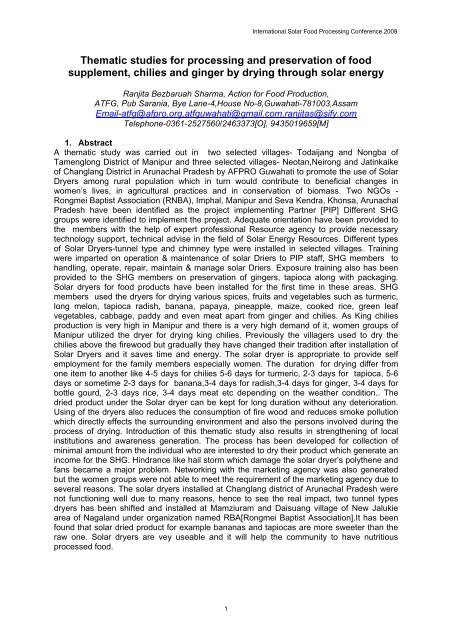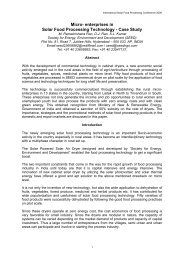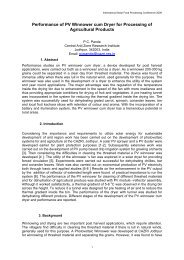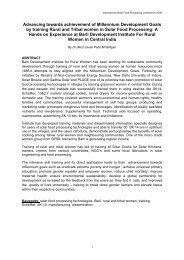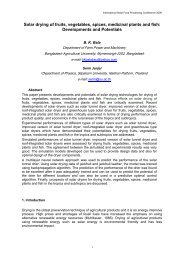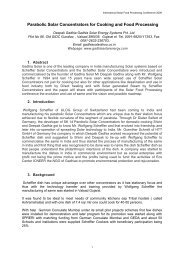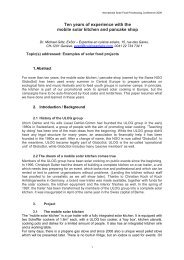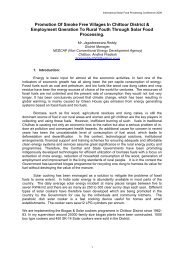Thematic studies for processing and preservation of food ... - Wikia
Thematic studies for processing and preservation of food ... - Wikia
Thematic studies for processing and preservation of food ... - Wikia
You also want an ePaper? Increase the reach of your titles
YUMPU automatically turns print PDFs into web optimized ePapers that Google loves.
International Solar Food Processing Conference 2009<br />
<strong>Thematic</strong> <strong>studies</strong> <strong>for</strong> <strong>processing</strong> <strong>and</strong> <strong>preservation</strong> <strong>of</strong> <strong>food</strong><br />
supplement, chilies <strong>and</strong> ginger by drying through solar energy<br />
Ranjita Bezbaruah Sharma, Action <strong>for</strong> Food Production,<br />
ATFG, Pub Sarania, Bye Lane-4,House No-8,Guwahati-781003,Assam<br />
Email-atfg@afpro.org,atfguwahati@gmail.com,ranjitas@sify.com<br />
Telephone-0361-2527560/2463373[O], 9435019659[M]<br />
1. Abstract<br />
A thematic study was carried out in two selected villages- Todaijang <strong>and</strong> Nongba <strong>of</strong><br />
Tamenglong District <strong>of</strong> Manipur <strong>and</strong> three selected villages- Neotan,Neirong <strong>and</strong> Jatinkaike<br />
<strong>of</strong> Changlang District in Arunachal Pradesh by AFPRO Guwahati to promote the use <strong>of</strong> Solar<br />
Dryers among rural population which in turn would contribute to beneficial changes in<br />
women’s lives, in agricultural practices <strong>and</strong> in conservation <strong>of</strong> biomass. Two NGOs -<br />
Rongmei Baptist Association (RNBA), Imphal, Manipur <strong>and</strong> Seva Kendra, Khonsa, Arunachal<br />
Pradesh have been identified as the project implementing Partner [PIP] Different SHG<br />
groups were identified to implement the project. Adequate orientation have been provided to<br />
the members with the help <strong>of</strong> expert pr<strong>of</strong>essional Resource agency to provide necessary<br />
technology support, technical advise in the field <strong>of</strong> Solar Energy Resources. Different types<br />
<strong>of</strong> Solar Dryers-tunnel type <strong>and</strong> chimney type were installed in selected villages. Training<br />
were imparted on operation & maintenance <strong>of</strong> solar Driers to PIP staff, SHG members to<br />
h<strong>and</strong>ling, operate, repair, maintain & manage solar Driers. Exposure training also has been<br />
provided to the SHG members on <strong>preservation</strong> <strong>of</strong> gingers, tapioca along with packaging.<br />
Solar dryers <strong>for</strong> <strong>food</strong> products have been installed <strong>for</strong> the first time in these areas. SHG<br />
members used the dryers <strong>for</strong> drying various spices, fruits <strong>and</strong> vegetables such as turmeric,<br />
long melon, tapioca radish, banana, papaya, pineapple, maize, cooked rice, green leaf<br />
vegetables, cabbage, paddy <strong>and</strong> even meat apart from ginger <strong>and</strong> chilies. As King chilies<br />
production is very high in Manipur <strong>and</strong> there is a very high dem<strong>and</strong> <strong>of</strong> it, women groups <strong>of</strong><br />
Manipur utilized the dryer <strong>for</strong> drying king chilies. Previously the villagers used to dry the<br />
chilies above the firewood but gradually they have changed their tradition after installation <strong>of</strong><br />
Solar Dryers <strong>and</strong> it saves time <strong>and</strong> energy. The solar dryer is appropriate to provide self<br />
employment <strong>for</strong> the family members especially women. The duration <strong>for</strong> drying differ from<br />
one item to another like 4-5 days <strong>for</strong> chilies 5-6 days <strong>for</strong> turmeric, 2-3 days <strong>for</strong> tapioca, 5-6<br />
days or sometime 2-3 days <strong>for</strong> banana,3-4 days <strong>for</strong> radish,3-4 days <strong>for</strong> ginger, 3-4 days <strong>for</strong><br />
bottle gourd, 2-3 days rice, 3-4 days meat etc depending on the weather condition.. The<br />
dried product under the Solar dryer can be kept <strong>for</strong> long duration without any deterioration.<br />
Using <strong>of</strong> the dryers also reduces the consumption <strong>of</strong> fire wood <strong>and</strong> reduces smoke pollution<br />
which directly effects the surrounding environment <strong>and</strong> also the persons involved during the<br />
process <strong>of</strong> drying. Introduction <strong>of</strong> this thematic study also results in strengthening <strong>of</strong> local<br />
institutions <strong>and</strong> awareness generation. The process has been developed <strong>for</strong> collection <strong>of</strong><br />
minimal amount from the individual who are interested to dry their product which generate an<br />
income <strong>for</strong> the SHG. Hindrance like hail storm which damage the solar dryer’s polythene <strong>and</strong><br />
fans became a major problem. Networking with the marketing agency was also generated<br />
but the women groups were not able to meet the requirement <strong>of</strong> the marketing agency due to<br />
several reasons. The solar dryers installed at Changlang district <strong>of</strong> Arunachal Pradesh were<br />
not functioning well due to many reasons, hence to see the real impact, two tunnel types<br />
dryers has been shifted <strong>and</strong> installed at Mamziuram <strong>and</strong> Daisuang village <strong>of</strong> New Jalukie<br />
area <strong>of</strong> Nagal<strong>and</strong> under organization named RBA[Rongmei Baptist Association].It has been<br />
found that solar dried product <strong>for</strong> example bananas <strong>and</strong> tapiocas are more sweeter than the<br />
raw one. Solar dryers are vey useable <strong>and</strong> it will help the community to have nutritious<br />
processed <strong>food</strong>.<br />
1
International Solar Food Processing Conference 2009<br />
2. Introduction<br />
Innovation <strong>of</strong> Renewable Energy technique is very important to replace traditional energy<br />
sources as an alternative to commercial fuels such as fire wood, coal, oil <strong>and</strong><br />
electricity.Peopl have drying <strong>food</strong> <strong>for</strong> thous<strong>and</strong>s <strong>of</strong> years by placing the <strong>food</strong> on mats in the<br />
sun. This simple method, however, allows the <strong>food</strong> to be contaminated by dust, airborne,<br />
molds <strong>and</strong> fungi, insects, rodents <strong>and</strong> other animals. Furthermore, open air drying is <strong>of</strong>ten<br />
not possible in humid climates. Dehydration or drying is a simple low cost way to preserve<br />
prevents fermentation or the growth <strong>of</strong> molds. Solar <strong>food</strong> dryers represent a major<br />
improvement upon this ancient method <strong>of</strong> dehydration <strong>food</strong>s. Although solar dryers involve<br />
an initial expense, they produce better looking, better test <strong>and</strong> more nutritious <strong>food</strong>s.<br />
Enhancing both their <strong>food</strong> value <strong>and</strong> their marketability. They also are faster, safer <strong>and</strong> more<br />
efficient than traditional sun drying techniques. Solar dryers use the energy <strong>of</strong> the sun to heat<br />
the air that flows over the <strong>food</strong> in the dryer. As air is heated, its relative humidity decreases<br />
<strong>and</strong> it is able to hold more moisture. Warm dry air flowing through the dryer carries away the<br />
moisture that evaporates from the surfaces <strong>of</strong> the <strong>food</strong>.<br />
3. Background<br />
<strong>Thematic</strong> <strong>studies</strong> <strong>for</strong> increase Agricultural Practices <strong>of</strong> <strong>food</strong> supplements, chillies <strong>and</strong> ginger<br />
<strong>and</strong> <strong>processing</strong> <strong>and</strong> <strong>preservation</strong> by drying through Solar Energy has been conducted under<br />
EED [Evangelischer Entwicklungsdienst (EED) Church Development Services, Germany] NE<br />
package VIII. The project, AFPRO-EED North east Package-VIII with the title ‘Community<br />
Natural Based Resource & Livelihood Development’ was the fifth package operating in the<br />
NE India, which was commenced in July, 2002 <strong>and</strong> concluded in September 2006. In the<br />
project area/villages supply <strong>of</strong> rural electricity is extremely uncertain <strong>and</strong> with excess cutting<br />
<strong>of</strong> firewood as a fuel <strong>for</strong> domestic use, <strong>for</strong>est cover being diminished. Solar Driers would be<br />
most efficiently utilized by theses growers [Ginger <strong>and</strong> chilli cultivators]. The solar dryer is<br />
appropriate to provide self employment <strong>for</strong> the family members especially women.<br />
Processing <strong>and</strong> <strong>preservation</strong> <strong>of</strong> cash crops close to their source will ensure fresher products<br />
<strong>and</strong> an even better quality product. There are no Co-operatives or Government outlets within<br />
the area as such the Marketing the Agri Products is entirely dependent on outsiders .Even<br />
the fresh fruits like bananas, oranges <strong>and</strong> pineapples <strong>and</strong> other fresh vegetables produce in<br />
a bulk <strong>and</strong> sold through middlemen who visit the villages <strong>and</strong> <strong>of</strong>fer their rates. The farmers<br />
are unable to sell their agricultural produce at competitive price.<br />
The focus was on Solar Driers <strong>and</strong> or continuous Tray Driers i.e. Solar Drying Techniques <strong>for</strong><br />
preserving <strong>food</strong> supplements (chilies <strong>and</strong> ginger) by drying. There are possibilities <strong>of</strong> drying<br />
fish, mushroom <strong>and</strong> fruits like banana <strong>and</strong> pineapples which are available in the project<br />
villages in abundance, emphasis being on chilies <strong>and</strong> ginger.Local women groups can earn<br />
money by producing (cultivating) chilies <strong>and</strong> ginger on large scale.<br />
This program on chilies <strong>and</strong> ginger product development has been undertaken with the<br />
following aim<br />
‣ Ginger <strong>and</strong> Chilies <strong>of</strong> the special variety is not preserved <strong>and</strong> processed on a<br />
commercial scale <strong>and</strong> their cultivation is limited as a perishable item <strong>for</strong> domestic<br />
consumption <strong>and</strong> <strong>for</strong> sale in local markets. However, if dried, preserved <strong>and</strong> packed<br />
both the <strong>food</strong> supplements have a wide range <strong>of</strong> marketing both <strong>for</strong> local <strong>and</strong> export<br />
markets.<br />
‣ To re-establish the image <strong>of</strong> chilies <strong>and</strong> ginger as a valuable resource among<br />
traditional users <strong>and</strong> local consumers.<br />
2
International Solar Food Processing Conference 2009<br />
‣ The produce to be brought to the <strong>processing</strong> centre <strong>of</strong> Seva Kendra <strong>and</strong> RNBA <strong>for</strong><br />
<strong>processing</strong> <strong>and</strong> <strong>preservation</strong> by drying <strong>and</strong> packing at the h<strong>and</strong>s <strong>of</strong> the women<br />
workers-thus creating an employment opportunity <strong>for</strong> rural women.<br />
‣ To assist village rural women to establish small enterprises a based on the local<br />
resources <strong>and</strong> manageable technology development<br />
4. Project<br />
The project is thematic <strong>studies</strong> <strong>for</strong> <strong>processing</strong> <strong>and</strong> <strong>preservation</strong> <strong>of</strong> <strong>food</strong> supplement,<br />
chilies <strong>and</strong> ginger by drying through solar energy<br />
4.1 Objective<br />
‣ To create awareness on Solar Energy issues <strong>and</strong> the capacity <strong>for</strong> energy planning,<br />
conservation <strong>and</strong> management at village level<br />
‣ To generate awareness <strong>and</strong> promote Solar drying Technology <strong>and</strong> increase the use<br />
<strong>of</strong> this technology in different project villages <strong>of</strong> the two states.<br />
‣ To motivate women, in particular, to be involved in the process <strong>and</strong> allowed to<br />
directly benefit from it.<br />
‣ To impart training <strong>and</strong> demonstration<br />
‣ To create skilled manpower<br />
‣ To create employment at micro level that exists within the villages<br />
‣ To build the capacity <strong>for</strong> managing <strong>and</strong> maintaining this system locally<br />
‣ To create awareness on appropriate Solar Energy resources to meet the<br />
requirement <strong>of</strong> the cultivators<br />
‣ To contribute to the rural poor through sustainable energy<br />
‣ Generate employment <strong>and</strong> encourage social integration<br />
4.2. Methodology<br />
Preliminary survey was conducted on both the states in particular villages <strong>for</strong> implantation <strong>of</strong><br />
the project. The two NGOs identified, Rongmei Baptist association[RNBA}-Imphal, Manipur<br />
<strong>and</strong> Seva Kendra, Khonsa, Arunachal Pradesh were selected as Project Implementing<br />
Partner[PIP]. Project Implementation Partners have been a long association with AFPRO<br />
since EED package programme started to implement in North East India [1996]. PIP were<br />
package partners <strong>of</strong> AFPRO since 12 years. On the basis <strong>of</strong> their per<strong>for</strong>mance PIPs has<br />
been selected <strong>for</strong> this project. Location selected were two villages namely Todaijang <strong>and</strong><br />
Nongba <strong>of</strong> Tomenglong District <strong>of</strong> Manipur <strong>and</strong> three villages namely Neotan, Neirong <strong>and</strong><br />
Jatinkaike <strong>of</strong> Changlang District in Arunachal Pradesh as project village. PIPs<br />
have mobilized the rural community [women SHGs <strong>and</strong> farmers] be<strong>for</strong>e starting the project<br />
<strong>and</strong> identified a group <strong>of</strong> personnels from the community preferably women self help group<br />
with proper consultation with Village development Committees [VDC]. The members <strong>of</strong> the<br />
group belong to particular village. The program has been designed particularly to empower<br />
women self help groups with solar assisted dryers <strong>and</strong> to create ownership as primary<br />
stakeholders. Thus women self help groups were identified as target group to implement the<br />
project. There are three SHGs namely-Banthampang consisting 27 members, Kapi SHG<br />
consisting 30 members <strong>and</strong> Diamchanglong with 22 members in Tamenglong district <strong>of</strong><br />
manipur <strong>and</strong> six Selp Help Groups(SHG) were selected in Changlang district <strong>of</strong> Arunachal<br />
Pradesh <strong>and</strong> they are- Sunshine, Milijuli, Shann, Menchan, Ajungban <strong>and</strong> Namphai<br />
Training <strong>and</strong> adequate orientation which was very much essential <strong>for</strong> PIPs has been<br />
achieved with the help <strong>of</strong> expert Resource Agency/person. It was proposed that the<br />
3
International Solar Food Processing Conference 2009<br />
Technical services in the field <strong>of</strong> Solar Energy resources would be provided through a<br />
pr<strong>of</strong>essional with experience in the field <strong>of</strong> Alternate Energy Resources. Accordingly, Solar<br />
Alternatives, St. Mary’s Church Compound, Phulwari Sharif, Patna-801501(Bihar) has been<br />
selected as a resource agency <strong>and</strong> Consultant identified was Rev. Fr. M. Mathews sj,<br />
Director Incharge <strong>of</strong> Solar Alternatives. Consultant provided necessary technical support,<br />
technical advice, training <strong>and</strong> orientation inputs in the field <strong>of</strong> Solar Energy.Training were<br />
imparted on operation & maintenance <strong>of</strong> solar Driers to PIP staff, SHG members to<br />
h<strong>and</strong>ling, operate, repair, maintain & manage solar Driers. Exposure training also has been<br />
provided to the SHG members on <strong>preservation</strong> <strong>of</strong> gingers, tapioca along with packaging.<br />
4.2.1. Pre Program Implementation:-<br />
Solar Alternatives, Patna has been identified as an implementation agency <strong>for</strong><br />
installation <strong>of</strong> the dryers in the project areas. The consultant, Rev. Fr. M. Mathews sj,<br />
Director Incharge <strong>of</strong> Solar Alternatives visited the project site Imphal during 15-16 th June,<br />
2005. RNBA, Imphal organized one workshop on ‘Solar <strong>and</strong> solar assisted drying <strong>and</strong><br />
<strong>processing</strong> programme on 17 th June, 2005 <strong>for</strong> the partners <strong>and</strong> community at Imphal during<br />
his visit. The team visited the project site <strong>of</strong> Seva Kendra, Khonsa on 19-20 th June, 2005 <strong>and</strong><br />
finalized the matter after receiving the basic in<strong>for</strong>mation’s on climate, household <strong>and</strong><br />
available agricultural products.<br />
4.2.2.Visit to Solar Alternatives Patna <strong>for</strong> Practical Demonstration <strong>of</strong> Solar Dryers<br />
proposed to be installed in project areas <strong>of</strong> RNBA & Seva Kendra:-<br />
Be<strong>for</strong>e signing the agreement with the Consultant, The AFPRO Guwahati coordinator <strong>and</strong> chief<br />
functionary <strong>of</strong> the PIPs visited the M/S Solar Alternatives during 29 th August – 01 st September,<br />
2005. After having observed the Solar Dryer system in the Solar Alternatives, Patna, based on<br />
technical design <strong>of</strong> the German model [ Solar tuneel dryer developed at the Institute <strong>for</strong><br />
Agricultural Engineering in the Tropics <strong>and</strong> subtropics <strong>of</strong> Hohenheim University, consists<br />
basically <strong>of</strong> a plastic foil-covered flat plate solar air heater, a drying tunnel <strong>and</strong> small axial flow<br />
fans. Some modifications have been suggested to suit the climatic conditions <strong>of</strong> the North East<br />
Region. The main changes which have been suggested in the model were the reduction in size<br />
<strong>and</strong> extra precaution <strong>for</strong> the protection <strong>of</strong> the plastic sheets [Transparent UV stabilized PE<br />
plastic foil, 0.2mm in thickness, with a transmissivity <strong>of</strong> 92% <strong>for</strong> visible radiation]<br />
Memor<strong>and</strong>um <strong>of</strong> Underst<strong>and</strong>ing (MoU) has been signed between the PIP <strong>and</strong> ATF-G on 24 th<br />
September, 2005 <strong>and</strong> 26 th September, 2005.<br />
Two different types <strong>of</strong> solar dryers were selected with little modification to suit the climatic<br />
condition <strong>of</strong> the region. They are Tunnel type(10 metres length/1.5m width) <strong>and</strong> Chimney<br />
type (5 trays measuring 30” by 10”) solar dryers. About 50 kg material <strong>and</strong> 5kg material can<br />
be dried in tunnel <strong>and</strong> chimney type dryers at a time respectively. Two solar dryers each <strong>of</strong><br />
Tunnel type <strong>and</strong> Chimney type have been installed at Manipur <strong>and</strong> Arunachal Pradesh<br />
during 5-8 th November, 2005 <strong>and</strong> 14-18 th December ,<br />
2005 by Solar Alternative, Patna- Bihar respectively. PIP supplied scale <strong>and</strong> weighing<br />
machine to the SHG to measure the quantity <strong>of</strong> raw <strong>and</strong> finished products.<br />
The main role <strong>of</strong> the PIPs were-<br />
‣ Provision <strong>of</strong> adequate space <strong>for</strong><br />
installation <strong>of</strong> solar Energy<br />
Appliances-Solar Dryers.<br />
‣ Provision <strong>of</strong> all possible assistance<br />
during installation <strong>of</strong> the dryers.<br />
‣ Mobilization <strong>of</strong> rural community<br />
(Women SHGs <strong>and</strong> farmers)<br />
4<br />
Solar Dryers (Tunnel <strong>and</strong> chimney type)
International Solar Food Processing Conference 2009<br />
‣ Identify a personal from the SHG to be trained in operation, repairs <strong>and</strong><br />
maintenance <strong>of</strong> Solar Dryers.<br />
‣ Marketing <strong>of</strong> finished product.<br />
The main role <strong>of</strong> Consultant/ Consulting Agency<br />
‣ Users Training on operation & maintenance <strong>of</strong> solar Driers to PIP staff<br />
‣ Train personals to h<strong>and</strong>ling, operate, repair, maintain & manage solar Driers<br />
‣ Orientation training to <strong>for</strong> the following personal<br />
‣ PIP field staff<br />
‣ Members <strong>of</strong> Self Help Groups<br />
‣ Farmers group<br />
Strategy has been prepared by PIP in consultation with the community <strong>for</strong> the commercial<br />
value <strong>of</strong> the dried product. Exposure training also has been arranged <strong>for</strong> the SHG members<br />
at Imphal <strong>and</strong> Assam Agricultural University, Jorhat <strong>for</strong> <strong>food</strong> <strong>processing</strong>, <strong>preservation</strong> <strong>and</strong><br />
marketing.<br />
4.2.3.Solar Dryers at Manipur<br />
Solar dryer <strong>for</strong> <strong>food</strong> products have been installed <strong>for</strong> the first time in these areas. The finance<br />
<strong>of</strong> the solar dryers met from EED package’s thematic study part. The transportation cost <strong>of</strong><br />
the solar dryers from the nearest railway station to the village <strong>and</strong> the local labour charge<br />
were the main financial contributions from the villagers. They need not had to pay any rent<br />
<strong>for</strong> the dryers.The dryers were installed in nearby places. The villagers are aware properly<br />
about the dryers <strong>and</strong> their utilization. They dried various spices, fruits <strong>and</strong> vegetables such<br />
as turmeric, long melon, tapioca radish, banana, papaya, pineapple, maize, cooked rice,<br />
green leaf vegetables, cabbage, paddy <strong>and</strong> even meat apart from ginger <strong>and</strong> chilies.<br />
Chimney type dryer has been installed in one <strong>of</strong> the residence the group members which is<br />
run by the women society. According to villagers the dried banana is much sweeter than raw<br />
one.<br />
According to villagers number <strong>of</strong> days<br />
require to dry are-<br />
Turmeric : 5-6 days<br />
Tapioca : 2-3 days<br />
Banana : 5-6 days<br />
King chillies: 5-6 days<br />
Radies: 3-4 days<br />
Chimney type dryer<br />
Ginger: 3-4 days<br />
bottle gourd: 3-4 days<br />
Rice: 2-3 days<br />
Meat: 3-4 days<br />
As King chilies production is very high in<br />
Manipur <strong>and</strong> there is a very high dem<strong>and</strong><br />
<strong>of</strong> it, women groups <strong>of</strong> Manipur utilized the<br />
dryer <strong>for</strong> drying king chilies. Previously the<br />
5
International Solar Food Processing Conference 2009<br />
villagers used to dry the chilies above the firewood but gradually they have changed their<br />
tradition after installation <strong>of</strong> Solar Dryers <strong>and</strong> it saves time <strong>and</strong> energy.In a tribal community<br />
<strong>food</strong> stuffs are dried <strong>and</strong> seasoned by using firewood which is not always good <strong>for</strong> health.<br />
According to the members women <strong>and</strong> children wasted most <strong>of</strong> their time in collection <strong>of</strong><br />
firewood from the hills <strong>of</strong> far away but after getting the dryers they slowly reduce the extra<br />
collection <strong>of</strong> firewood which was required early <strong>for</strong> drying the same <strong>food</strong> stuff to store <strong>for</strong> the<br />
<strong>of</strong>f season. The solar dryer is appropriate to provide self employment <strong>for</strong> the family members<br />
especially women. One person has been given responsibility to take care <strong>of</strong> the dryers <strong>and</strong><br />
he was doing well.<br />
4.2.4.Solar Dryers in Miao, Arunachal Pradesh<br />
Initially after installation <strong>of</strong> the dryers in the villages different types <strong>of</strong> fruits <strong>and</strong> vegetables<br />
were dried like tapioca, radies, chilies, banana, pineapple, papaya, turmeric, ginger, tomato,<br />
bottle gourd, meat etc.<br />
But after 3 months the solar dryers became non-functional due to damage caused by a hail<br />
storm. It was repaired again. Chimney type dryers were used to dry only household produce<br />
<strong>for</strong> own consumption. As the concept was very new <strong>and</strong> SHGs were also very new to use the<br />
dryer so some hindrance aroused <strong>and</strong> they had to be motivated very frequently. The SHGs<br />
are not able to dry agricultural produce on a larger scale due to less production level which<br />
was not at commercial level. They require a huge production <strong>for</strong> marketing the same, The<br />
income generated from the dryers was such that the beneficiaries were not able to generate<br />
money from the dryers but they were capacitated enough about the technique. During<br />
monitoring PIP co-ordinator expressed that it will be better to shift the dryers to a nearby<br />
place where they would be at least used <strong>for</strong> commercial purposes. According to him it is <strong>of</strong><br />
no use in spending money maintaining them if there is no return out <strong>of</strong> it. The SHGs were too<br />
dependent on PIP <strong>for</strong> its maintenance <strong>and</strong> repair.<br />
Some <strong>of</strong> the records maintained by two SHG members as cited below[Record <strong>of</strong> one<br />
season]<br />
Location : Neoton<br />
Sl no Dried goods Quantity dried<br />
1 Ginger 83 kg<br />
2 Maiz 41 kg<br />
3 Turmeric 12 kg<br />
4 Cooked rice 17 kg<br />
5 Chilli 22 kg<br />
6 Tapioka 45 kg<br />
Location : Neirong<br />
Sl no Dried items<br />
Quantity<br />
dried<br />
1 Vegetables:green<br />
46 kg<br />
leaf,cabbage<br />
2 Fruits 32 kg<br />
3 Meat 8 kg<br />
4 Paddy 90 kg<br />
6
International Solar Food Processing Conference 2009<br />
5 Maiz 38 kg<br />
6 Spices: Chilli, ginger, 19 kg<br />
Turmeric<br />
Status <strong>of</strong> chimney type dryers at Neotan <strong>and</strong> Jatinkakai<br />
Sl Dried items Neotan<br />
(quantity)<br />
Jatikakai<br />
(quantity)<br />
1 Chilli 2 kg 5 kg<br />
2 Haldi 4 kg 9 kg<br />
3 Maiz 21 kg 33 kg<br />
4 Rice 8 kg -<br />
5 Fruits <strong>and</strong> 15 kg 4 kg<br />
vegetables<br />
6 Nuts - 1 kg<br />
7 Tapioca - 6 kg<br />
4.3. Result & Observations<br />
The duration <strong>for</strong> drying differ from one item to another like 4-5 days <strong>for</strong> chilies 5-6 days <strong>for</strong><br />
turmeric, 2-3 days <strong>for</strong> tapioca, 5-6 days or sometime 2-3 days <strong>for</strong> banana,3-4 days <strong>for</strong><br />
radish,3-4 days <strong>for</strong> ginger, 3-4 days <strong>for</strong> bottle gourd, 2-3 days rice, 3-4 days meat etc<br />
depending on the weather condition.. The dried product under the Solar dryer can be kept <strong>for</strong><br />
long duration without any deterioration. Using <strong>of</strong> the dryers also reduces the consumption <strong>of</strong><br />
fire wood <strong>and</strong> reduces smoke pollution which directly effects the surrounding environment<br />
<strong>and</strong> also the persons involved during the process <strong>of</strong> drying. Introduction <strong>of</strong> this thematic<br />
study also results in strengthening <strong>of</strong> local institutions <strong>and</strong> awareness generation. The<br />
process has been developed <strong>for</strong> collection <strong>of</strong> minimal amount <strong>of</strong> money( Rs.0.5 from group<br />
member <strong>and</strong> Rs.1 per kg material dried from other villagers ) from the individual who are<br />
interested to dry their product which generate an income <strong>for</strong> the SHG. Hindrance like hail<br />
storm which damage the solar dryer’s plastic <strong>and</strong> fans became a major problem. Networking<br />
with the marketing agency was also generated but the women groups were not able to meet<br />
the requirement <strong>of</strong> the marketing agency due to several reasons verbal communication as<br />
the SHG members only can communicate through local language. Another reason was<br />
Produced were not so high to meet the dem<strong>and</strong> <strong>of</strong> the marketing agency. In this point also<br />
they require training to know the process like at a lot what amount they should collect <strong>for</strong><br />
drying <strong>and</strong> management <strong>of</strong> time.<br />
The solar dryers installed at Changlang district <strong>of</strong> Arunachal Pradesh were not functioning<br />
well due to many reasons, hence to see the real impact, two tunnel types dryers has been<br />
shifted <strong>and</strong> installed at Mamziuram <strong>and</strong> Daisuang village <strong>of</strong> New Jalukie area <strong>of</strong> Nagal<strong>and</strong><br />
under organization named RBA [Rongmei Baptist Association] during February, 2008. RBA<br />
was interested to install the dryer as there is a heavy market dem<strong>and</strong> <strong>for</strong> organic product<br />
produced by the villagers. The wastage <strong>of</strong> fruit items like mangoes, jackfruit, pineapples,<br />
gooseberries, bamboo shoots, naga (raja) chilly, green leaves <strong>and</strong> beans are high due to<br />
heavy production <strong>and</strong> lack <strong>of</strong> storage technique. So if solar energy can be utilized <strong>for</strong> drying<br />
these item then villagers will have nutrious <strong>food</strong> even <strong>for</strong> longer time.SHGs are happy to get<br />
these new technology <strong>of</strong> drying as their excess <strong>food</strong> item usually thrown as wastage.<br />
7
International Solar Food Processing Conference 2009<br />
The project at Manipur is running well <strong>and</strong> they have a great dem<strong>and</strong> on dried tapioca <strong>and</strong><br />
king chillies.<br />
During monitoring it was observed that villagers were aware about the dryers <strong>and</strong> their<br />
utilization.<br />
‣ The members <strong>of</strong> SHGs used dryers <strong>for</strong> domestic purposes<br />
‣ Hail-stones have done damaged to the drier<br />
‣ Nominal amount has been charged by the groups from individual who use the<br />
dryer.<br />
‣ People are keen to engage in income generation project with immediate gains.<br />
‣ SHGs are not able to reach a consensus on business activities.<br />
‣ People used the dryer <strong>for</strong> preserving household/perishable goods<br />
‣ It is easy to maintain this type <strong>of</strong> dryers<br />
‣ Organization <strong>of</strong> the SHG <strong>and</strong> strengthen them is a major task.<br />
‣ Frequent <strong>and</strong> constant monitoring cum encouraging <strong>of</strong> SHG is very important<br />
5. Conclusion<br />
It has been found that solar dried product <strong>for</strong> example bananas <strong>and</strong> tapiocas are sweeter<br />
than the raw one. Solar dryers are vey useable <strong>and</strong> it will help the community to have<br />
nutritious processed <strong>food</strong>. All the SHGs should come together <strong>and</strong> <strong>for</strong>mulate the overall<br />
strategies covering maintenance <strong>of</strong> the dryers, optimum utilization <strong>of</strong> the dryers, packaging <strong>of</strong><br />
the dried product, marketing <strong>of</strong> the finished product. Ef<strong>for</strong>ts were made from PIP sides <strong>for</strong><br />
strengthening the SHG members. As regards the marketing is concerned all the PIPs were<br />
introduced to M/s. Agribusiness <strong>and</strong> requested to become the member <strong>of</strong> this marketing<br />
network. Regarding different shapes <strong>of</strong> the vegetables <strong>and</strong> fruits while cutting <strong>for</strong> the purpose<br />
<strong>of</strong> drying also has been demonstrated according to the consumer’s choice at market. Fruits<br />
like banana should be cut as round shaped so that it has a look <strong>for</strong> marketing. Monitoring is<br />
utmost important <strong>for</strong> success <strong>of</strong> the project.Initialy many hindrance may come but with proper<br />
strategy, awareness, maintenance <strong>and</strong> frequent monitoring, the project will be a successful<br />
venture. As a pilot study this project generated awareness <strong>and</strong> learnings about use <strong>of</strong><br />
solar energy among all who has associated with it.<br />
8
International Solar Food Processing Conference 2009<br />
Tapioca under tunnel dryer<br />
Drying <strong>of</strong> turmeric & tapioca<br />
9


